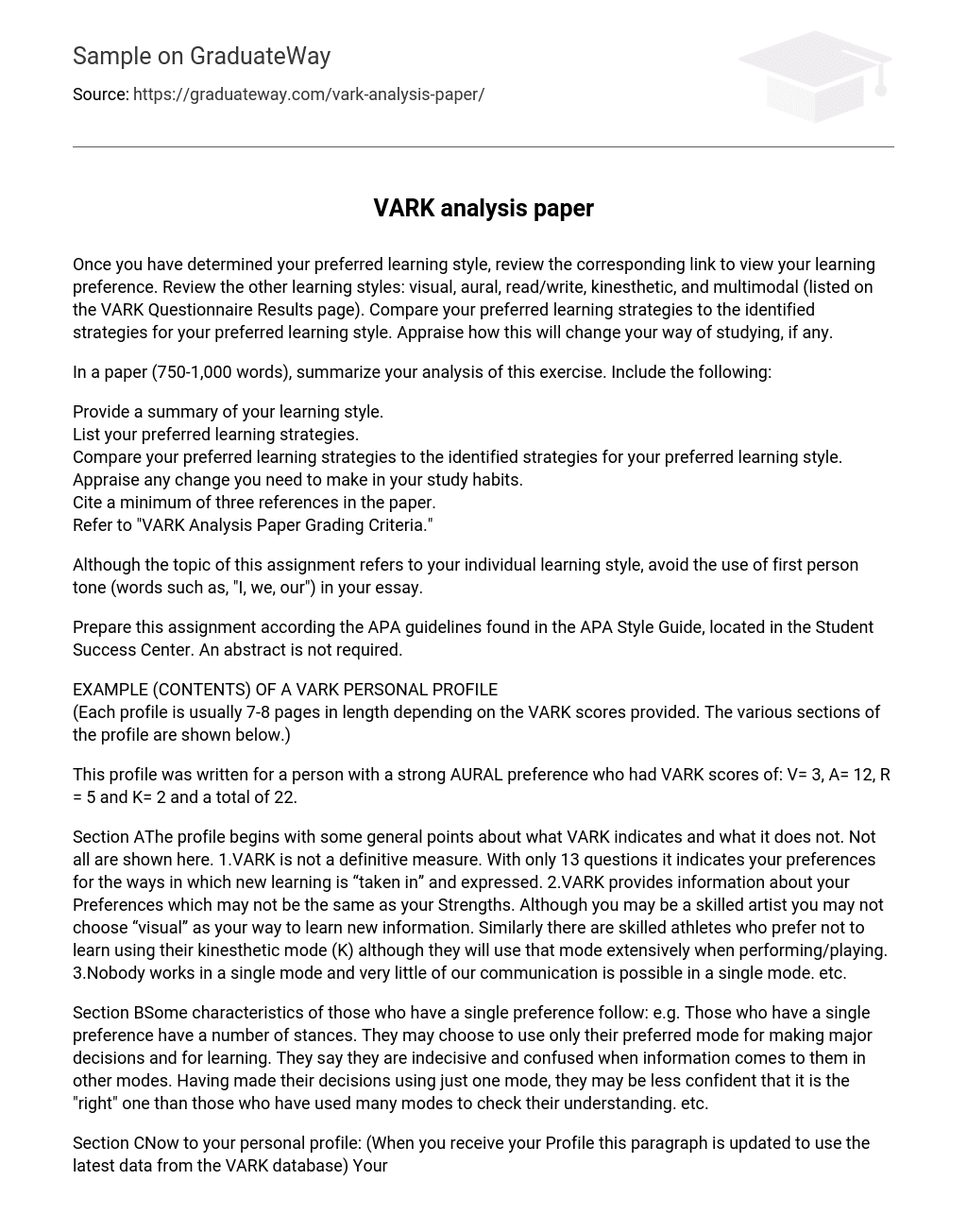After determining your preferred learning style, you should check the corresponding link to see your learning preference. Also, take a look at the other learning styles mentioned on the VARK Questionnaire Results page: visual, aural, read/write, kinesthetic, and multimodal. Compare your preferred learning strategies with the strategies identified for your preferred learning style. Evaluate how this will affect your studying approach, if at all.
In a 750-1,000-word paper, summarize your analysis of this exercise. Include the following:
In the paper, summarize your learning style and list your preferred learning strategies. Compare these strategies to the identified strategies for your learning style and evaluate if any changes in study habits are necessary. Additionally, include a minimum of three references and refer to the “VARK Analysis Paper Grading Criteria.”
The essay for this assignment should not use a first-person tone (words such as “I, we, our”), even though it is about your individual learning style.
Follow the APA guidelines in the APA Style Guide for this assignment, which can be found in the Student Success Center. No abstract is necessary.
EXAMPLE (CONTENTS) OF A VARK PERSONAL PROFILE
(Each profile typically spans 7-8 pages, depending on the given VARK scores. The profile comprises different sections as indicated below.)
This individual has a strong preference for auditory learning, as evidenced by their VARK scores. Their scores indicate a preference for auditory learning with a score of 12, with visual and reading preferences scoring 3 and 5 respectively, and a score of 2 for kinesthetic learning. Overall, their total VARK score is 22.
Section A: The profile of VARK provides some general points about its indications and limitations. It is important to note that VARK is not a definitive measure and only uses 13 questions to indicate preferences for learning and expressing new information. VARK focuses on preferences, which may differ from strengths. For example, someone may be a skilled artist but not choose “visual” as their preferred learning mode. Similarly, there are athletes who do not prefer the kinesthetic mode (K) for learning but use it extensively during performance or play. It is crucial to understand that no one works in a single mode and most communication involves multiple modes.
Section B
Some traits of individuals with a sole preference are as follows. For instance, those with a solitary preference possess various viewpoints. They opt to exclusively utilize their preferred method for important decision-making and acquiring knowledge. They admit to feeling uncertain and perplexed when information is presented to them using alternative methods. By solely relying on one mode, they may have less assurance in its validity compared to individuals who employ multiple modes to verify their comprehension. etc.
Section C Now to your personal profile: (When you receive your Profile this paragraph is updated to use the latest data from the VARK database) Your Aural/Oral preference is extremely strong. Your score of 12 surpasses the scores of the other modes by a significant margin. In our April-June 2005 database of 19000 people, only 3% of respondents belonged to the same category as you – individuals with an Aural preference – and your preference is classified as Very Strong. Other individuals may have Aural as a secondary preference or as part of a set of preferences involving multiple modes, but those who exhibit mild, strong, or very strong Aural preferences constitute a small group. etc.
Section D: Graphs and Tables. Here, the most recent graph of preferences and a table displaying percentages with a similar profile are included.
Section E: Strategies for learning as an individual with an Aural-preference.
Section F (1-2 pages)
1. Tips for utilizing an Aural preference as a student.
2. Strategies for utilizing an Aural preference in communication and collaborations.
This section provides a case study of a student with a similar Aural profile in the GA case study.
Section H: The Profile concludes with the relevant Helpsheet(s).





